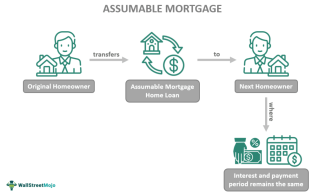
Housing Market's Hidden Gem: Assumable Mortgages
Amged Baker, a 40-year-old software developer, wanted to move to a bigger home as the Florida native transitioned into a new role at work that allowed him to be permanently remote. He also wanted more space for his two kids.
But Baker, who works for a real-estate platform, knew that it wasn’t that simple to trade up. Mortgage rates had doubled and home prices continued to rise. In his hometown of Palm Beach County, Fla., home prices soared by nearly 60% over the last five years.
He sold his previous home for $600,000, which had a 30-year mortgage rate of 2.8%. However, he was prepared to give up that rate if he could avoid paying a rate of 7%.
Baker was intrigued by assumable loans. Having refinanced his current home during the pandemic, he was keenly aware of the value of his ultra-low mortgage. He knew his monthly payments would be a lot more affordable with an assumable mortgage — and so his search began.
He’s not alone. It appears to be the housing market’s latest obsession — homeowners, buyers, and real estate agents are all talking about assumable mortgages.
Across real-estate brokerage sites, listings boast that the home comes with an “assumable mortgage,” described in glowing terms as a “rare find,” “game-changer,” or as one buyer said on social media, “white whale.”
What Are Assumable Mortgages?
With assumable mortgages, the loan — and, importantly, its interest rate — is passed from the seller to the buyer when a house changes hands.
With the U.S. housing market frozen by high rates and low inventory, it’s clear why people have turned their attention to assumable loans. They’re particularly appealing now because they offer homeowners a way to potentially capitalize on their pandemic-era ultra-low mortgage rate by passing it on.
Here’s the catch: Only certain types of loans can be assumable mortgages. The seller must have a government-backed home loan, which is insured by the Federal Housing Administration, Veterans Affairs, or certain loans by the U.S. Department of Agriculture. These government agencies allow homeowners to transfer ownership of the mortgage to a new home buyer under certain conditions such as the new buyer having good credit, an acceptable debt-to-income ratio, and more.
For the typical home buyer today who is facing a 30-year mortgage with a rate over 7%, assuming an existing mortgage with an interest rate as low as 1.75% is an enticing proposition. It offers an alternative to buying points — fees a borrower pays the lender to cut the mortgage rate on their home loan — or taking out an adjustable-rate mortgage, which comes with its own risks.
For the seller, an assumable mortgage presents another feature to play up when listing their home. There is also, perhaps, some comfort in knowing that their ultra-low interest rate will be inherited by the buyer.
How Do Assumable Mortgages Work?
So how do they work? Imagine an aspiring homeowner views a home valued at $375,000, and the home comes with an assumable mortgage of $225,000. The buyer in this situation will need to put down $150,000 in cash or find other financing after they assume the mortgage.
If the buyer requires secondary financing, it will likely come at a higher interest rate, which will offset some of the savings from the assumable mortgage. Nonetheless, for homeowners who are keen on selling, if they have an assumable mortgage, their house will become more attractive to buyers.
“Veterans across the country are sitting on these ultra-low rates,” Chris Birk, vice president of mortgage insight at Veterans United Home Loans, told MarketWatch. “So they’ve got this incredible marketing opportunity.”
And yet of the 69,000 VA purchase loans that his company processed in 2022, only about two dozen were assumptions.
There’s a lack of awareness about assumable loans, Jason Mitchell, chief executive of Jason Mitchell Group, a Scottsdale, Ariz.-based real-estate brokerage, told MarketWatch.
The first question real-estate agents should ask homeowners who are listing their homes is whether their mortgage is assumable. “If you can mark it as an assumable mortgage at 3.5%, you’re gonna get a better price on your house,” he added.
Finding an Assumable Rate of 3.05%
Baker and Tapia attended 20 open houses in Palm Beach County.
They made four offers and ultimately closed on a four-bedroom single-family home in Palm Beach County for $620,000. Baker took over the seller’s 30-year fixed-rate mortgage, under the assumption rules. It has a 3.05% rate.
He currently holds a Federal Housing Administration loan with an outstanding balance of $324,000. As a result, he put down $269,000 in cash.
The seller had only paid off about 3 years on their 30-year loan, so Baker took it over with a monthly payment of about $1,500. He estimated that buying the home with a conventional mortgage at the prevailing rate would cost closer to $2,300 a month.
Baker closed on the home in June 2023, and because he assumed the seller’s loan he did not have to pay thousands of dollars in closing costs.
“You will be hearing about assumable loans more often,” Tapia, the broker, said.
Baker agreed. “To be honest with you, it was always a good deal — it was always better than going the conventional route,” he said.
As the housing market grapples with surging mortgage rates and rising home prices, the buzz around assumable mortgages continues to grow. These mortgages offer a unique opportunity for homeowners to pass on their ultra-low interest rates when selling their homes. Assumable mortgages can be a game-changer in the current market, offering both buyers and sellers a unique advantage. As the housing market adapts to new challenges, we can expect to hear more about these intriguing loans.
Read the full article here!

